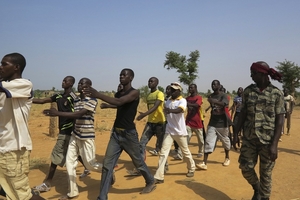We have received and are glad to publish this article from Antonella Freggiaro, President of Abarekà Nandree, a non-profit organization that since 1999 has been implementing projects in Mali, with the purpose to improve education, health and quality of life.
On Friday January 11th, 2013, in the evening, the interim president of Mali, Diocouda Traore, declared a state of emergency by beginning hostilities against the “Salafis” Islamic groups (one of the most harsh and violent extremist groups of Islam), who have been practicing on the population of northern Mali the fundamentalist forms of sharia – with stonings and amputations as punishment – since March 2012 and who recently attacked the army in order to move forward to the south of the country.
France came straight into action with air raids, and government troops reoccupied Konnà, which fell in rebel hands on Thursday. The President of Mali promised that the rebels will suffer a “whipping and strong” military reaction and that the conflict will last as long as necessary to regain the integrity of the country. Now the war has begun and we don’t know how long it will last.
But how did all this begin?
Mali, mainly inhabited by Sufi Muslims (one of the most moderate and mystical tendencies of Islam), became independent in 1960. It started with a non-religious government, and only one socialist and nationalist party which was defeated by a military coup in 1968. In 1991 a further military coup led to the adoption of a Constitution which allowed for the existence of multiple political parties. Nevertheless, only one party dominated the political scene, the ADEMA. Given the, theoretical, multiparty election system, the Mali regime was crowned from the West as a “democratic” and exemplary system up to the beginning of 2012.
Throughout this period, politicians and public administrators have been coming from ethnic groups based in the south of the country (representing 40% of the territory, and the most densely populated), while the remaining 60% (desert for the most part) is mainly inhabited by Tuareg groups. These groups, often put aside by the central government and rebelling from time to time, decided to build an independent state. Many Tuareg escaped to Libya, joining the army. The confusion following Gaddafi’s death allowed Tuareg soldiers with weapons and money to return to Mali in order to begin the struggle for Azawad (name of their future independent state). They organized themselves as the MNLA (National Movement for Liberation of Azawad).
On March 22nd in Bamako, the capital of Mali, a group of officials led by Amadou Haya Sanogo announced a third post-independence military coup. France, the United States and some West African countries declared their strong opposition to the military coup and demanded the return of the previous government. An agreement was reached with great difficulty between Sanogo forces and the old regime, assigning a new “interim” president, while in the north the MNLA Tuaregs searched for alliances with more fundamentalist groups. The latter were almost immediately set aside by the MNLA and took the control of all the main cities of northern Mali.
The most fundamentalist elements belong to three different groups: Ansar Eddine (local Tuareg), Al Qaeda of Maghreb (AQIM), mostly composed of foreigners, and the Movement for Tawhid and Jihad in West Africa (MUJAO). These groups control different areas of the country and it is quite unclear what brings them together, both from a tactical point of view and from their targets. Definitely, all of them want to establish a fundamentalist Islamic republic in Mali.
Before the jihadist offensive in Konnà, the United States, France and other Western countries hoped to be able to gather a large part of the three thousand components of the Mali army within the summer, supporting them with a few thousand soldiers from ECOWAS (the West African regional organization). It seems that the Italian military police (Carabinieri) contributed to train of Mali soldiers. With western air cover, logistics and intelligence, this motley coalition was supposed to have launched in the autumn an offensive intended for regaining the three northern cities controlled by the rebels: the legendary Timbuktu, on the southern border of the desert, Gao, and Kidal.
This was to be done all under the umbrella of the 2071 Resolution, unanimously adopted on October 12th by the UN Security Council, authorizing military intervention in Mali. Romano Prodi assumed the role of special envoy of the United Nations and did his best for months to build relationships between African and Western diplomacies, in an attempt to allay the crisis, divide the jihadist front, and prevent the collapse of what remains of Mali, a former regional “model of democracy”.
But any attempt at mediation has failed and the emergency put pressure on Paris to immediately intervene on its own (or nearly alone). The bet at stake is its historical status of “policeman” in the Maghreb, Sahara and Sahel and access to energy resources, which the former African empire needs (uranium, gas, oil). The French industry giants are implicated with their exploitation of the natural resources with Areva in the lead.
This is the situation today: a military intervention was necessary in order to stop the advance of the jihadist groups and to prevent that the whole country becoming a fundamentalist Islamic republic.
In addition to the concern for the fate of the people and the country, a fundamental question remains: was this war really unavoidable? Once again, is violence the only answer against usurpation and abuse?
An answer is difficult to give at the moment, since all attempts to mediate with the fundamentalist groups have failed miserably and the people of Mali are against the Sharia. We can only hope that this war will not last too long or be too painful ….
Antonella Freggiaro
Translation from Italian by Matilde Mirabella










